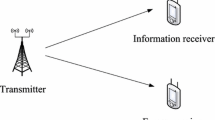Abstract
A low complexity antenna selection scheme for multicarrier MIMO (Multiple Input Multiple Output) broadcast systems is proposed in this paper. Under special condition of single user in the system or when the number of subcarrier is only one, the system reduces to conventional MIMO-OFDM (Orthogonal Frequency Division Multiplexing) system or MIMO-BC (Broadcast Channel) system respectively. By analysing sub-optimal antenna selection schemes developed earlier for single user MIMO-OFDM systems and single carrier MIMO-BC systems, one can see many similarities which can be extended to multicarrier MIMO broadcast systems. The proposed method exploits these similarities to obtain a low complexity system design with acceptable performance. The performance of the proposed scheme is studied via extensive simulation, and the computational complexity involved is compared to the conventional scheme. A selection gain of approximately 0.5 b/s/Hz is shown to be achievable using only two out of three antennas, and the proposed scheme is able to achieve up to 90% of the gain. This is achieved at a complexity that is significantly lower than the conventional methods, hence the practical implementation of the proposed scheme can be justified.







Similar content being viewed by others
References
Teletar, E. (1995). Capacity of multi-antenna gaussian channels. AT&T-Bell Labs Internal Tech. Memo.
Foschini, G. J., & Gans, M. J. (1998). On limits of wireless communications in a fading environment when using multiple antennas. Springer Journal on Wireless Personal Communication, 6, 311–335.
Foschini, G. J. (1996). Layered space-time architecture for wireless communication in a fading environment when using multi-element antennas. Bell Labs Technical Journal, 1, 41–59.
Alamouti, S. M. (1998). A simple transmit diversity technique for wireless communications. IEEE Journal on Selected Areas in Communications, 16, 1451–1458.
Tarokh, V., Jafarkhani, H., & Calderbank, A. R. (1999). Space-time block codes from orthogonal designs. IEEE Transactions on Information Theory, 45, 1456–1467.
Gore, D. A., & Paulraj, A. (2002). MIMO antenna subset selection with space-time coding. IEEE Transactions on Signal Processing, 50, 2580–2588.
Heath, R. W., Sandhu, S., & Paulraj, A. (2001). Antenna selection for spatial multiplexing systems with linear receivers. IEEE Communications Letters, 5, 142–144.
Jensen, M. A., & Morris, M. L. (2005). Efficient capacity-based antenna selection for MIMO systems. IEEE Transactions on Vehicular Technology, 54, 110–116.
Weinstein, S. B., & Ebert, P. M. (1971). Data transmission by frequency-division multiplexing using the discrete fourier transform. IEEE Transactions on Communications, COM-19, 628–634.
Bingham, J. A. C. (1990). Multicarrier modulation for data transmission: An idea whose time has come. IEEE Communications Magazine, 28, 5–14.
Bahceci, I., Duman, T. M., & Altunbasak, Y. (2004). Performance of MIMO antenna selection for space-time coded OFDM systems. IEEE Wireless Communucations and Networking Conference, 2, 987–992.
Shao, X., Yuan, J., & Rapajic, P. (2003). Antenna selection for MIMO-OFDM spatial multiplexing system. In IEEE Int. Symp. on Inform. Theory (p. 90).
Kurniawan, E., Madhukumar, A. S., & Chin, F. (2007). Sub optimal antenna selection method for MIMO-OFDM systems. In IEEE Vehicular Technology Conference (pp. 435–439).
Kurniawan, E., Madhukumar, A. S., & Chin, F. (2007). Antenna selection technique for MIMO-OFDM systems over frequency selective Rayleigh fading channel. IET Communications, 1, 458–463.
Jindal, N., & Goldsmith, A. (2005). Dirty-paper coding versus TDMA for MIMO broadcast channels. IEEE Transactions on Information Theory, 51, 1783–1794.
Yu, W., & Cioffi, J. (2004). Sum capacity of Gaussian vector broadcast channels. IEEE Transactions on Information Theory, 50, 1875–1892.
Kurniawan, E., Madhukumar, A. S., & Chin, F. (2009). Heuristic antenna selection algorithm for multiuser multi-antenna downlink. In IEEE Vehicular Technology Conference (to appear).
Li, Y., Winters, J. H., & Sollenberger, N. R. (2002). MIMO-OFDM for wireless communications, signal detection with enhanced channel estimation. IEEE Transactions on Communications, 50, 1471–1477.
Siwamogsatham, S., & Fitz M. P. (2002). Robust space-time codes for correlated Rayleigh fading channels. IEEE Transactions on Signal Processing, 50, 2408–2416.
Costa, M. (1983). Writing on dirty paper. IEEE Transactions on Information Theory, IT-29, 439–441.
Sato, H. (1978). An outer bound to the capacity region of broadcast channels. IEEE Transactions on Information Theory, IT-24, 374–377.
Jindal, N., Vishwanath, S., & Goldsmith, A. (2004). On the duality of Gaussian multiple-access and broadcast channels. IEEE Transactions on Information Theory, 50, 768–783.
Vishwanath, S., Jindal, N., & Goldsmith, A. (2002). On the capacity of multiple input multiple output broadcast channels. In IEEE International Conference on Communications (pp. 1444–1450).
Vishwanath, S., Jindal, N., & Goldsmith, A. (2003). Duality, achievable rates, and sum-rate capacity of Gaussian MIMO broadcast channels. IEEE Transactions on Information Theory, 49, 2658–2668.
Jindal, N., Rhee, W., Vishwanath, S., Jafar, S. A., & Goldsmith, A. (2005). Sum power iterative water-filling for multi-antenna Gaussian broadcast channels. IEEE Transactions on Information Theory, 51, 1570–1580.
Hsieh, M., & Wei, C. (1998). Channel estimation for OFDM systems based on comb-type pilot arrangement in frequency selective fading channels. IEEE Transactions on Consumer Electronics, 44, 217–225.
Acknowledgements
The authors would like to thank the reviewers and the editors for their helpful comments, which have significantly improved the presentation of this paper.
Author information
Authors and Affiliations
Corresponding author
Rights and permissions
About this article
Cite this article
Kurniawan, E., Madhukumar, A.S. & Chin, F. Low Complexity Antenna Selection Scheme for Multicarrier MIMO Broadcast Communication. J Sign Process Syst 62, 247–262 (2011). https://doi.org/10.1007/s11265-009-0347-2
Received:
Revised:
Accepted:
Published:
Issue Date:
DOI: https://doi.org/10.1007/s11265-009-0347-2




